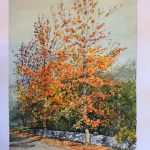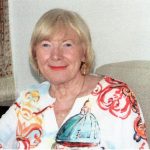I don’t know about everyone else, but at last night’s rehearsal I thought that we were finally getting to grips with the Little Jazz Mass. It has taken some time, but it was gratifying to feel that all the hard work which we – and more noticeably Carlos – have put in over past weeks is bearing fruit.
Last night was our twelfth rehearsal for this concert, and there are five more to go.
Anne and I we musing about rehearsals last weekend whilst listening to the final of the Young Performer of the Year. The three soloists were stunning. They may be young in years but they all displayed great musical maturity. It is a shame that only one can win, but we felt sure that they would all make successful careers in music.
But as for rehearsals, we thought not so much about the soloists but more about the orchestra. They had to accompany three concertos at very short notice. One, the Beethoven Violin Concerto, is well-known, and most orchestral players will have performed it several times. But the other two works, a Weber Clarinet Concerto and a Prokoviev Piano Concerto, are much less well-known, and the latter piece in particular is fiendish to play. I wonder how many rehearsals they had. Two, perhaps, or maybe three…….and maybe some individual practice time beforehand. That they played all three pieces flawlessly is a tribute to both their hard work and their innate musical talent.
In the five rehearsals we have left for Love, Peace and all that Jazz, we have to tidy up some loose notes and then really get into the spirit of each piece. It’s all fantastic music, and, with Carlos’ continued teaching and encouragement, I am sure that we will do justice to it.
 This is the second of three articles about MWC members who are active in an artistic field other than music. This week I am delighted to feature Helen Reid, who joined the sopranos a few years ago, having previously sung with the Newcastle University Choir.
This is the second of three articles about MWC members who are active in an artistic field other than music. This week I am delighted to feature Helen Reid, who joined the sopranos a few years ago, having previously sung with the Newcastle University Choir. . “The result varies with the thickness and quality of the underlying paper and the air temperature, which means quick or slow drying of adjoining areas of paint. The difference in grain size of the pigments for different colours means that, in water, each colour runs and flows at different rates, often giving unexpected results. Some colours push others aside quite rudely; some are soft, gentle, retreating. Tiny variations in the amount of water can mean sharp edges to objects or quite unpredictable flows and runs on colour into one another. As well as being a constant challenge, the medium is a constant delight as you explore its qualities and infinite variation.”
. “The result varies with the thickness and quality of the underlying paper and the air temperature, which means quick or slow drying of adjoining areas of paint. The difference in grain size of the pigments for different colours means that, in water, each colour runs and flows at different rates, often giving unexpected results. Some colours push others aside quite rudely; some are soft, gentle, retreating. Tiny variations in the amount of water can mean sharp edges to objects or quite unpredictable flows and runs on colour into one another. As well as being a constant challenge, the medium is a constant delight as you explore its qualities and infinite variation.” Helen most enjoys painting subjects which have some personal meaning for her. Examples which she has kindly agreed to be included in this article are flowers from a friend’s garden, a gulley near Alice Springs she once visited and a tree across the road from her home. She says that inspiration comes from feeling a connection with the subject, something these pictures bear out. It goes without saying that the photographs do not do anything like full justice to the actual paintings.
Helen most enjoys painting subjects which have some personal meaning for her. Examples which she has kindly agreed to be included in this article are flowers from a friend’s garden, a gulley near Alice Springs she once visited and a tree across the road from her home. She says that inspiration comes from feeling a connection with the subject, something these pictures bear out. It goes without saying that the photographs do not do anything like full justice to the actual paintings. What next? An exhibition perhaps? Helen is not that keen on botanical or zoological subjects (Guy Troughton’s speciality) but would like to tackle the challenge of portaiture. It will be interesting to see the results!
What next? An exhibition perhaps? Helen is not that keen on botanical or zoological subjects (Guy Troughton’s speciality) but would like to tackle the challenge of portaiture. It will be interesting to see the results! at a number of Choir members have not only musical but also other artistic talents? One such is Cindy Broadbent, whose voice has augmented the mellifluous tones of the altos for the past eight years or so and whose first novel, The Afghan Wife, was published last year.
at a number of Choir members have not only musical but also other artistic talents? One such is Cindy Broadbent, whose voice has augmented the mellifluous tones of the altos for the past eight years or so and whose first novel, The Afghan Wife, was published last year. Cindy describes The Afghan Wife as a love story set against the background of the Iranian revolution in 1979. Having read and thoroughly enjoyed it, I would add that in addition to the love story, there is a high level of action with many twists and turns in the plot, not unlike a John Buchan story such as The Thirty Nine Steps.
Cindy describes The Afghan Wife as a love story set against the background of the Iranian revolution in 1979. Having read and thoroughly enjoyed it, I would add that in addition to the love story, there is a high level of action with many twists and turns in the plot, not unlike a John Buchan story such as The Thirty Nine Steps.